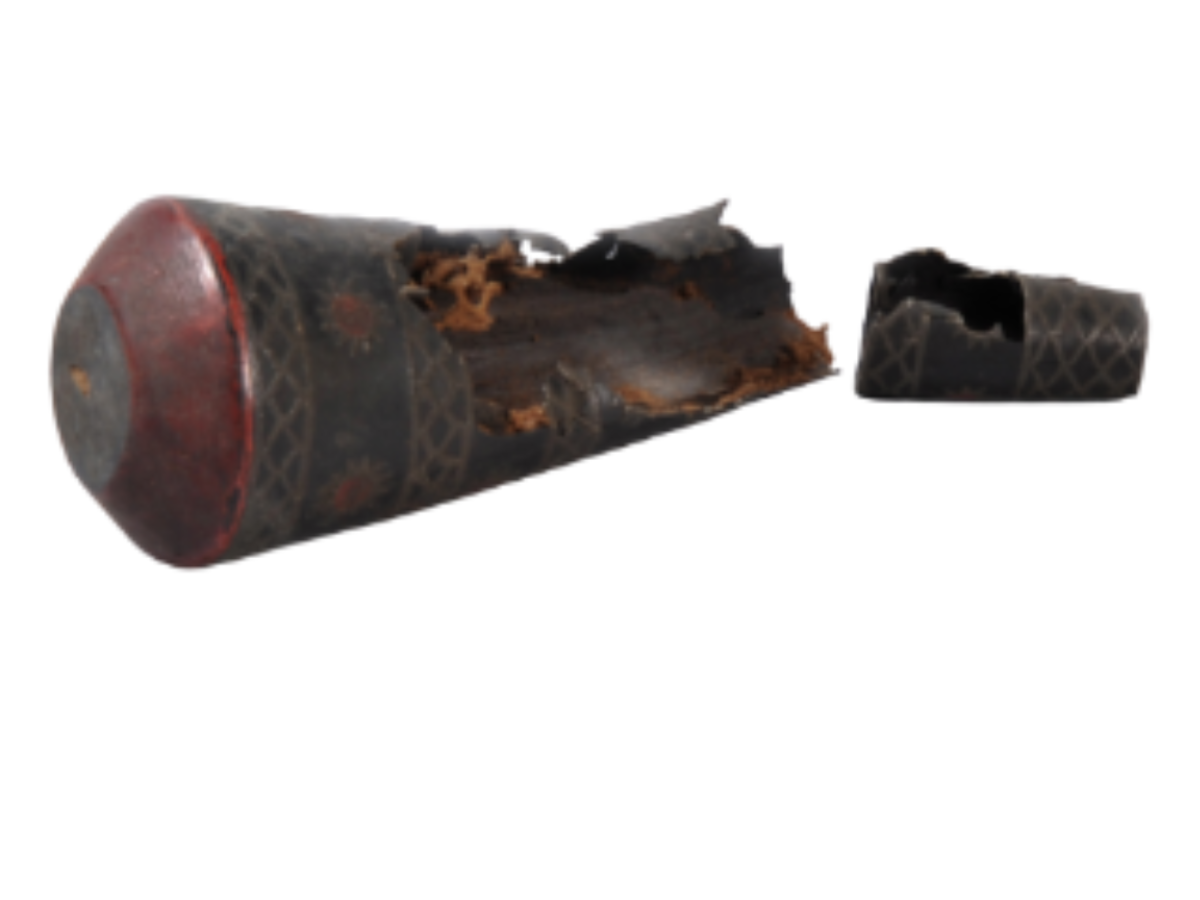State
Tribe Name
Art Type
short description
An obscure indigenous community, the Shindo tribe possesses specialized knowledge about material culture and products that sustain them in their daily life. The Shindo bottle, one of the rare artifacts, is said to have been traditionally used for the storage of the tobacco juice, which is a substitute for betal in the tribe's culture by its womenfolk.
Made out of animal horn, the Shindo bottles were witness to the ingeniousness of the tribe and their affinity with nature. The body surface of the bottle is usually embellished with red and black painted designs symbolizing the community's aesthetics and symbols. The way strong colors are used may indicate tribal identity or individual ownership, whereas the ornamentation features traditional motifs probably handed down through successive generations.
This bottle holds great significance in the social and ritual life of Shindoo women. The usage of tobacco juice instead of chewing betel leaves is one such unique feature that lays emphasis on the variations in the culture from one indigenous group to another.
Sadly, many of these artifacts, including this one, are deteriorating and poorly preserved through the vicissitudes of age and neglect, thus losing their significance. However, they serve as very valuable ethnographic objects in documenting the tribe's way of life and their means of artistic expression. It is very essential to preserve such artifacts if a living link is to be kept with their tribal heritage and traditional knowledge systems.
Made out of animal horn, the Shindo bottles were witness to the ingeniousness of the tribe and their affinity with nature. The body surface of the bottle is usually embellished with red and black painted designs symbolizing the community's aesthetics and symbols. The way strong colors are used may indicate tribal identity or individual ownership, whereas the ornamentation features traditional motifs probably handed down through successive generations.
This bottle holds great significance in the social and ritual life of Shindoo women. The usage of tobacco juice instead of chewing betel leaves is one such unique feature that lays emphasis on the variations in the culture from one indigenous group to another.
Sadly, many of these artifacts, including this one, are deteriorating and poorly preserved through the vicissitudes of age and neglect, thus losing their significance. However, they serve as very valuable ethnographic objects in documenting the tribe's way of life and their means of artistic expression. It is very essential to preserve such artifacts if a living link is to be kept with their tribal heritage and traditional knowledge systems.
Thumbnail

Filter Postion
Right
Filter Background
Off
Theme
Filter Header Image

content
Image

description
An obscure indigenous community, the Shindo tribe possesses specialized knowledge about material culture and products that sustain them in their daily life. The Shindo bottle, one of the rare artifacts, is said to have been traditionally used for the storage of the tobacco juice, which is a substitute for betal in the tribe's culture by its womenfolk.
Made out of animal horn, the Shindo bottles were witness to the ingeniousness of the tribe and their affinity with nature. The body surface of the bottle is usually embellished with red and black painted designs symbolizing the community's aesthetics and symbols. The way strong colors are used may indicate tribal identity or individual ownership, whereas the ornamentation features traditional motifs probably handed down through successive generations.
This bottle holds great significance in the social and ritual life of Shindoo women. The usage of tobacco juice instead of chewing betel leaves is one such unique feature that lays emphasis on the variations in the culture from one indigenous group to another.
Sadly, many of these artifacts, including this one, are deteriorating and poorly preserved through the vicissitudes of age and neglect, thus losing their significance. However, they serve as very valuable ethnographic objects in documenting the tribe's way of life and their means of artistic expression. It is very essential to preserve such artifacts if a living link is to be kept with their tribal heritage and traditional knowledge systems.
Made out of animal horn, the Shindo bottles were witness to the ingeniousness of the tribe and their affinity with nature. The body surface of the bottle is usually embellished with red and black painted designs symbolizing the community's aesthetics and symbols. The way strong colors are used may indicate tribal identity or individual ownership, whereas the ornamentation features traditional motifs probably handed down through successive generations.
This bottle holds great significance in the social and ritual life of Shindoo women. The usage of tobacco juice instead of chewing betel leaves is one such unique feature that lays emphasis on the variations in the culture from one indigenous group to another.
Sadly, many of these artifacts, including this one, are deteriorating and poorly preserved through the vicissitudes of age and neglect, thus losing their significance. However, they serve as very valuable ethnographic objects in documenting the tribe's way of life and their means of artistic expression. It is very essential to preserve such artifacts if a living link is to be kept with their tribal heritage and traditional knowledge systems.
Image Mode
landscape
promoted
Off
Verified
Off
